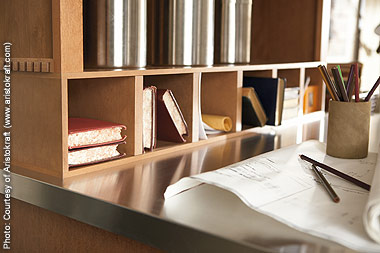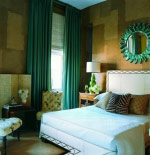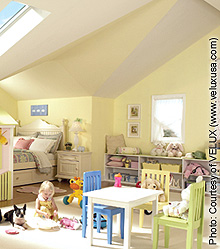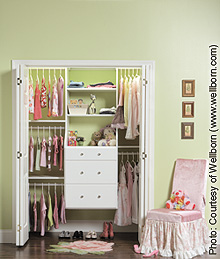01 Mar 2014
Color Forecast 2014
“The state of color is constantly changing and gathers influence from the world around us,” says Jackie Jordan, director of color marketing for Sherwin-Williams. Each year Jordan, along with her color experts, surveys these swirling global currents and selects key colors that capture a picture of the latest color trends. For the Sherwin-Williams Colormix 2014 forecast, Jordan has chosen 38 colors that are grouped into the four palettes she describes below. Feel free to use these colors as design inspiration when planning your next home remodeling project.
Read More
15 Jan 2014
Color of the Year for 2014 – Radiant Orchid
The Pantone Color Institute, a global color authority, announced that Radiant Orchid, a captivating, magical, enigmatic purple, as the Color of the Year for 2014. “While the 2013 color of the year, Emerald, served as a symbol of growth, renewal and prosperity, Radiant Orchid reaches across the color wheel to intrigue the eye and spark the imagination,” said Leatrice Eiseman, Executive Director of the Pantone Color Institute®.
Since 2000, the Pantone Color Institute has been designating a Color of the Year to express in color what is taking place in the global zeitgeist. A color that will resonate around the world, the Color of the Year is a reflection of what people are looking for and what they feel they need that color can help to answer.
The New Hue on the Block
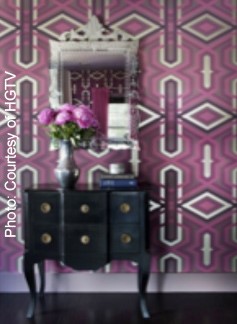
California Home & Design (CAHD) a favorite for design trends, inspiration, house tours, and product finds, cleverly introduced the new color: “Meet Radiant Orchid, the new hue on the block.” According to CAHD, you’ll start seeing the energizing, romantic color everywhere – in fashion, beauty, and interiors. “Infused with edgy undertones of majestic purples and sassy pinks, this shade is putting us all under its spell.” Their recommendation is to pair Radiant Orchid with Neutrals, Greens and even Reds. Eiseman suggested using Radiant Orchid to complement olive and deep hunter-greens. “It’s gorgeous when paired with turquoise and teal.”
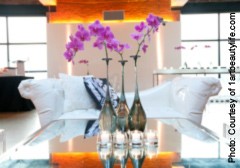
The Color Marketing Group forecasts what colors will be “in” so manufacturers of everything from fabrics to futons, carpet to cars, and dresses to dishes, can gear up. Mark Woodman, its President advises “Pair it with care.” This year’s violet can change completely, depending on the combination. “With gray, it would be regal”, with an acid green or yellow, it would be completely energized. With an earthy brown and deeper green, it would feel organic”.
Woodman’s advice is to mix it in – “you don’t need too much. The slightest touch of a top-trend color can quickly update a room. This year’s purple is a phenomenal accent color”. Take a tired piece of furniture and add the trend color with a throw blanket, pillows, candle or even flowers.
If you need a little help getting started on how to integrate Radiant Orchid into your home, see the resources section at in the left hand column.
15 Nov 2013
Universal Design in the Kitchen
Universal Design (UD) is an architectural movement that seeks to create living environments that function well for everyone, regardless of age or ability. In Europe it is called “Design for All”. A growing trend in this country is to use the term “Better Living Design” so people do not confuse UD with accessible design.
UD accommodates a broader spectrum of people than accessible design, which follows guidelines set by the Americans with Disabilities Act (ADA) and is specifically for those who are aging or those with a physical disability. The purpose of UD is to benefit a wide population that may include the elderly along with small children, pregnant women, parents with baby strollers, and homeowners carrying shopping bags into their homes. UD is particularly on target to meet the needs of the rising number of multi-generational households in the United States.
The wonderful appeal of UD includes the fact that it is transparent: accommodations are felt rather than seen. Homes designed according to UD principles feel pleasant and inviting, rather than cold and institutional.
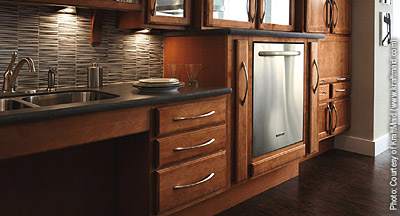
When your home is designed using UD principles it provides a beautiful, safe, convenient, and easy-to-use environment for you and your family, as well as for anyone else who comes to visit.
Here are twenty examples of Universal Design principles that you can utilize in your next kitchen remodeling project. Most people will not realize anything is different from the norm; nevertheless, your kitchen will be comfortable for a more diverse range of people.
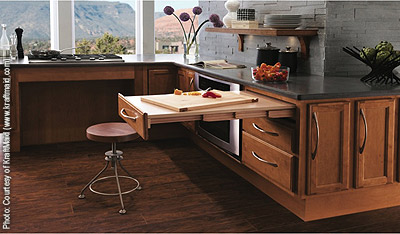
- Materials that are non-allergenic and free of VOCs
- 5′ diameter open space for maneuverability
- Non-slip flooring that is water resistant and easy to maintain
- No throw rugs or mats, unless recessed into the floor
- Rocker-style light switches and lever-style door handles
- Three layers of light: task, ambient and accent; light for way-finding
- Natural light from windows, skylights or solar tubes
- Medium to light colored, non-glare surfaces
- Full extension pull-out drawers in base cabinets, rather than shelves
- Higher toe-kick on base cabinets
- Upper cabinets installed 15″ above the countertop, instead of the standard 18″
- Glass doors in wall cabinets for good visibility of the contents
- Easy-to-grasp cabinet door handles
- Raised dishwasher with adjacent landing space
- Knee space under the cook-top and sink
- Multiple-height countertops
- Single lever, high arc faucets with pull-out or pull-down sprays; hands-free technology
- Whole-house anti-scald valve set at 120 degrees
- Induction cook-top for safety and energy savings
- Interior cabinet lighting should be a cool temperature (LED) to protect contents
01 Nov 2013
Home for the Holidays
In anticipation of holiday visitors and guests, have fun sprucing up your home to make their visit more enjoyable with things that you’ll enjoy throughout the year. Whether you have a dedicated guest room or need to convert an office into a bedroom for holiday guests, here are a few ideas to get you started.
Begin with your home’s exterior
Refresh Your Entry
Your home’s entrance makes an important first impression. Refresh your entry with a new coat of paint on the front door. And if the trim is starting to look weathered, scrape and repaint those areas as well.
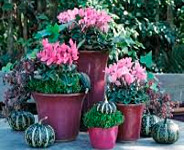 Deck Out Your Planters
Deck Out Your Planters
While you have the paint can open, paint planters and window boxes in the same color as your trim or door. Then, add some seasonal color by filling the window boxes with annuals such as Cyclamen, primroses, stock and decorative kale.
Another idea is to use real or artificial holly, pomegranates, birch sticks and greenery to create a holiday planters. Top them off with a string of tiny white lights to brighten the front entrance.
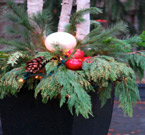 Clear the Clutter and Light the Way
Clear the Clutter and Light the Way
Remove any clutter from your front entrance and pick-up leaves and other debris by the front door. Test bulbs in your exterior light fixtures to ensure they safely illuminate pathways and steps. Add a new doormat that extends a warm welcome to your visitors.
Then move into the interior
 Add comfort
Add comfort
Wondering how you are going to turn your home office into a B&B for your house guests? Consider a versatile Wall Bed/Murphy Bed. Wall beds open to a normal resting height and accommodate any standard mattress. They are space savers, safe and easy opening and no comfort is lost ! For more ideas and wall bed options, check out our trusted friends at Valet Custom Cabinets and Closets.
 And that Special Touch
And that Special Touch
You can always count on Martha Stewart for ideas to make people feel welcome and to ensure that their time spent with you is memorable.
An easy example she gives is to keep sets of guest towels together, bound with twill tape or ribbon. When visitors arrive, just transfer a stack from linen closet to guest bedroom.
Click here for a checklist that will help you impress your guest.
15 Oct 2013
Three Essentials of a Perfect Home Office
You may need a home office for keeping up with family finances, or for telecommuting, or for a small business with regular clients. Whichever it may be, we recommend these three essentials for creating a perfect home office.
1. Allow for Privacy
In years past, a home office often consisted of a desk tucked into a corner of the kitchen. The intention was to help a busy homeowner multi-task: prepare meals, watch kids, and pay bills all at the same time. This concept is no longer so popular, since the kitchen has increasingly become the place in the home where everyone congregates. Homeowners need a quieter location to concentrate on family business without constant interruptions and distractions. Today the home office is usually located in a separate room adjacent to the kitchen. Keeping the office door open provides a sight-line to the kids, but closing the door allows privacy when necessary. If this arrangement is not feasible in your home, another option is to install tall bookcases in the kitchen (or family room) to divide the office area from the rest of room.
2. Include Daylighting
Home offices are sometimes set up quickly with little forethought. They are squeezed into whatever space is easily available, such as a large hall closet or under a staircase. If ample lighting is not provided, these spaces can be disappointingly dark and gloomy. Ideally, a home office should have windows or skylights that allow natural daylight into the area. Some of the benefits of natural daylight include helping energize your body and uplift your mood by increasing serotonin levels. It can also help your immune system by boosting the body’s production of Vitamin D. Plentiful general and task lighting should be installed in addition, utilizing daylight-replicating light sources. It is important, however, to avoid creating a glare on your computer screen from the overhead lights.
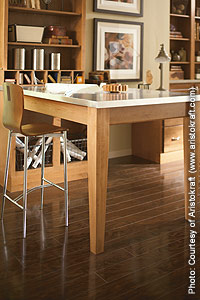 3. Select the Right Furnishings & Equipment
3. Select the Right Furnishings & Equipment
Homeowners will often purchase a standard office desk, filing cabinet and bookcase when they outfit a home office. As time goes by, they may discover that this arrangement does not function well for their particular business needs. It is best to plan ahead: make a list of all your various business activities, and start thinking outside the box. Do you need a large, flat surface on which to work? Perhaps a table would suit your needs better than a desk. Would a number of small cubbies serve your purposes better than open bookshelves? Consider ergonomics as you are selecting your office furnishings and deciding where to store equipment and supplies. Heavier items that you may need to lift should be located at waist height to avoid back strain. Invest in the fastest, most reliable office equipment you can afford, from your cell phone to your printer. This will pay you back with time dividends in the final analysis.
01 Mar 2013
We’re Off to See the Wizard
Wondering how to pull nature indoors, as well as promote balance and harmony? See the article on the Color of the Year for 2013 and find out how Emerald Green can add Glam to any room.
Update your Home with this Season’s Hottest Hue, and Color of the Year – Emerald Green.
 Pantone LLC, the global authority on color and provider of professional color standards for the design industries, announced that PANTONE®17-5641 Emerald- a lively, radiant, lush, green, is the Color of the Year for 2013.
Pantone LLC, the global authority on color and provider of professional color standards for the design industries, announced that PANTONE®17-5641 Emerald- a lively, radiant, lush, green, is the Color of the Year for 2013.
According to the Pantone website, Emerald, a vivid, verdant green, enhances our sense of well-being by inspiring insight, as well as promoting balance and harmony. Most often associated with brilliant, precious gemstones, emerald green is sophisticated and luxurious. Since antiquity, this luminous hue has been the color of beauty and new life in many cultures and religions. It’s also the color of growth, renewal and prosperity – no other color conveys regeneration more than green.
“Green is the most abundant hue in nature – the human eye sees more green than any other color in the spectrum,” said Leatrice Eiseman, Executive Director, Pantone Color Institute. “As it has throughout history, multifaceted Emerald continues to sparkle and fascinate. Symbolically, Emerald brings a sense of clarity, renewal and rejuvenation, which is so important in today’s complex world. This powerful and universally appealing tone translates easily to both fashion and home interiors.”
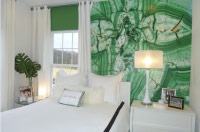 According to Shawn Gauthier, a design enthusiast and freelance writer for Houzz, “Emerald green pulls nature indoors.” Summer is just the right time to use this rich and elegant shade to tie interior and outdoor spaces together.
According to Shawn Gauthier, a design enthusiast and freelance writer for Houzz, “Emerald green pulls nature indoors.” Summer is just the right time to use this rich and elegant shade to tie interior and outdoor spaces together.
Visit Houzz for wonderful photos, like the one above from Carlyn And Company Interiors + Design and ideas on how to incorporate this color trend throughout your home.
01 Oct 2012
Functional & Flexible Kid’s Rooms
When you’re designing your child’s room, it’s tempting to begin by purchasing a comforter set from his or her favorite Disney character–say Perry the Platypus–and then go from there. Bright teal-green walls with tangerine accents, and you’re in business, until next year, that is, when your child prefers a different cartoon hero. Keep reading for our tips on designing bedrooms that are flexible enough to transition through all stages of your children’s lives.
Parents love to delight their children with fanciful bedrooms that resemble a princess castle or a pirate den. But how can you design bedrooms that both fit your children’s needs and imaginations right now, yet are flexible enough to fulfill their needs and desires as they grow and mature?
The bedroom should function well for your child’s activities and well-being.
- Kid’s rooms should provide ample storage for clothing, toys, books and games, and make that storage easy for them to use, so they can clean up after themselves. One of the best solutions is built-in cabinetry that is anchored to the bedroom wall, since children will often try to climb.
- Include some open shelving, cubbies and baskets, which are easier for smaller children to manipulate than deep drawers and large closet doors.
- Install several clothing hooks inside and outside the closets, since these are simpler for children to use than hangers.
- Include a table, desk or built-in desktop for completing arts and crafts projects or schoolwork, along with seating that provides good back support and encourages healthy posture.
- Make certain this area is well-lit to avoid eyestrain. General overhead room lighting is important, as well as task lighting specifically focused on the activity area.
- Kids like to personalize their rooms. Allow them to express themselves by providing a chalkboard or install a cork board where they can attach their artwork. If your child is a budding artist, paint a section of the bedroom wall with chalkboard paint.
- Choose materials and finishes that are easy care and non-toxic, such as low or no-VOC paints, stains or sealants. Select natural flooring materials, such as hardwood, cork, bamboo or real linoleum (Marmoleum), rather than carpet that can harbor allergens or vinyl that can emit harmful fumes.
The bedroom should be flexible enough to perform well into the future
- Children grow up more rapidly than parents expect, and their needs change quickly. Unless you want to completely re-do your child’s bedroom every year, design the bedroom for flexibility.
- Avoid choosing a juvenile theme for your child’s bedroom that he or she will quickly outgrow. Choose cabinet finishes and paint colors that can form a backdrop for your child’s ever changing interests.
- Select a crib that transitions into a toddler bed and then later into a regular twin or full bed. It will save you the cost of purchasing a new bed as your child ages, and may make the adjustment for your child easier as well.
- Install adjustable rods and poles in the closet, so the space can evolve to fit various clothing sizes as your child matures.
- Include a comfortable adult-size lounge chair or loveseat for reading books or cuddling with your child. The same lounge chair, transformed by the addition of some colorful new throw pillows, can serve your child during the teen years.
23 May 2012
Color Forecast 2012
Are you longing to tear down walls and transform the dark, closed-off rooms in your home into open light-filled spaces that connect to the outdoors? You want your home to feel refreshed, invigorated, and up-to-date. But how can you know your color selections won’t go out of style in a year or two, making your new space look dated? The 2012 colormixTM forecast from Sherwin-Williams helps give you confidence in choosing colors for your remodeling project.
Jackie Jordan, director of color marketing for Sherwin-Williams, points out that a dominant trend this year is for pairing colors within the same color family–but not the expected tone-on-tone pairings we’ve seen in the past. The new color forecast features 40 hues in four vibrant palettes that help you discover a fresh array of combinations within color families.
Reds Burn Brightly
This vibrant palette includes hues of brilliant flowers and glowing embers. It isn’t a single red, but a deep gradation of fuchsias, red-oranges, violets and delicate pinks. “Red has a renewed dominance,” Jordan said. “But the old taboos about mixing reds with oranges and purples don’t apply.

Blues Not Washed Out
This soothing palette celebrates a pair of functional and treasured blues: denim and water. It explores the darkest indigo to faded-jeans hues, some with violet undertones, as well as the calm, shimmery shades that reflect rivers, lakes and seas.

Greens Firmly Planted
Representing a shift from some of the yellow-tinged greens of the past, this eclectic palette focuses on greens that are lush, moody and complex. It showcases the depths of the sea and forest, leafy motifs, rustic natural textures, and organic elements such as algae, moss and seaweed.

Neutrals Provide Balance
Raw materials continue to influence color trends, especially the more subtle hues. Picture a field of grain, pile of pebbles, weathered wood and earthen clay. Gold tones embody the sun and soft metallics–and warm up this understated yet refined palette. Textural elements, such as linen, unfired porcelain and mixed woods, provide subtle variations.
01 Feb 2012
Jewelry for Your Cabinets
In an interior remodeling project, cabinetry is often one of the larger expenditures, so it makes sense to choose your cabinets carefully. You want to be certain you have the storage capacity and functionality you need. The height and depth of the cabinets are also taken into consideration. You want the cabinet style, wood species and finishes to create that fabulous look you have in mind — the perfect fit for your personality and tastes.

One small detail that is often overlooked is the decorative hardware. Yet sometimes it is the tiniest detail that makes the biggest impact and leaves a lasting impression. While still in the planning stage of your project, take some quality time to select your decorative hardware.
One of your first considerations should be how the hardware feels to your hand. Since you continually open and close your cabinet doors and drawers, hand comfort and accessibility is vital. The hardware should project out from your cabinet far enough to protect the cabinet finish from sharp fingernails or oil from your fingers. For some people with limited hand mobility, a pull may be easier to grasp than a knob. In this case, test it out and make sure it is large enough to grip with the entire hand.
Secondly, your decorative hardware should coordinate with the style and proportion of your cabinets. When used appropriately, decorative hardware doesn’t clamor for its own individual attention, but rather intensifies the loveliness of your cabinet, and thereby influences the look of the entire room. A long, lean stainless steel pull beautifully accentuates a streamlined European-style cabinet. A vintage-style cabinet becomes even more lovely when set off by an elegant period piece garnished with gemstones.

Finally, when making your choices, remember to have fun and be creative. You do not have to match every piece of hardware from room to room. Too much similarity throughout your home decreases the excitement. Select something out-of-the-ordinary that fits your personal style and adds vitality to the room.
Currently the trend is for oversized decorative hardware, along with coordinating appliance pulls for the kitchen. Unique knobs and pulls are available in a wide range of materials, from metal, porcelain and glass to stone, wood and even leather. The most popular metal finishes are brushed nickel, stainless steel, polished chrome, and hand-rubbed finishes in bronze, pewter and antique brass.
15 May 2011
Get Organized!
Get Organized!
Though it might seem hard to justify spending money on something you “should” be able to do yourself, hiring a professional organizer will likely pay for itself in time savings and stress reduction. When you can quickly and easily find a document without digging through stacks of papers to find it, or you reach into your closet and find only clothes you like, or you have a toy storage strategy that keeps toys out of every room in your home, you’ll have more time to do what you enjoy. And, we have a local, professional organizer to recommend. Her name is Amanda Kuszak, founder of Kuzak’s Closet.
While televisions shows like Clean House and Hoarders have gained popularity of late, you don’t have to be a pathological hoarder to benefit from the services of a professional organizer. Sometimes you just need permission to get help with something you’ve been putting off or a push to get past your inertia. Making an appointment with a professional, like Amanda, can give you the impetus to get started.
![]()
;?>/images/hamanda.jpg” class=”shadow-frame toleft sizeabtus”></p>
<p>Contact Amanda at:<br />
<a href=) kuzakscloset@gmail.com
kuzakscloset@gmail.com
650-646-4343
www.kuzakscloset.com
http://blog.kuzakscloset.com


